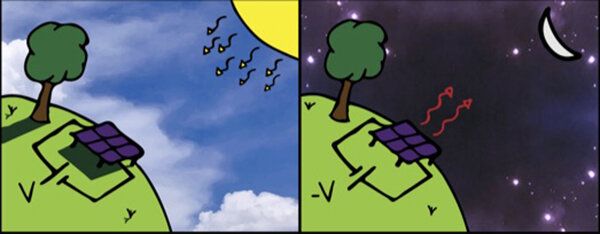
🌙 A solar panel that can operate at night
A new paper describes a PV solar panel system that can still generate electricity long after the sun has gone down.
Share this story!
An often mentioned (and quite obvious) drawback of photovoltaic solar panels is that the sun needs to be shining, or at least present, for power generation to occur. And for countries with long winter nights, there’s a good chunk of the year during which your shiny solar panel installation will sit tragically idle for more than half of every day, generating nothing but mild annoyance.
But a new paper by Jeremy Munday, professor in the Department of Electrical and Computer Engineering at UC Davis, and his graduate student Tristan Deppe, describes a PV system that appears, at first glance, to be almost magical — solar panels that can still generate electricity even long after the sun has gone down.
The whole thing works using Radiative Sky Cooling. A hot surface, when facing something colder, will automatically lose heat through radiation. That’s radiative cooling in action, and one reason why curtains are used to keep our rooms, and ourselves, warm at night. The night sky, hovering as it does at a frosty three degrees above absolute zero, is about as cold as you can get, and therefore a terrific heat sink for anything warmer that’s facing it.
Radiative Sky Cooling also requires no extra energy input, being a totally passive process. It is also well understood and widely used in cooling systems as well as in experimental systems designed to recover waste heat from engines.
Munday and Deppe wondered if they could apply this concept to solar panels. Since a standard PV panel generates electricity by a photon of light striking it, perhaps you could do the same thing in reverse — generate electricity when a photon leaves a specially designed thermoradiative cell (TR) on its way into deep space.
The magic happens like this. Anything in thermal contact with the Earth will retain a temperature of approximately three hundred degrees Celsius higher than deep space, even at night. This temperature difference is used to generate power in the TR cell. According to the paper:
“…an ideal TR cell at 300 K coupled with a 3 K radiating body (deep space) has a maximum power output of 54 W/m2.”
Standard solar cells produce a maximum of about 200 W/m2 in strong sunlight, so by coupling one of these with a TR cell that can operate at night, or by having a separate bank of TR panels that could be rolled out over the standard PV panels, power generation for a given area could be increased by as much as 25%. And by having some power generation at night, reliance on expensive battery packs and fossil-fuel powered generators would be reduced, making solar energy installations a much more attractive proposition, albeit at a higher cost.
Munday and Deppe are currently focused on improving their prototype device, to turn their theories into reality. And, who knows, in a few years from now we might be cooling the planet to make our electricity instead of heating it.
Illustrated image source: zmescience.com
Want to get a dose of fact-based optimism in your mailbox once a week? Don't miss subscribing to our newsletter.
Warp News is run by the nonprofit Warp Institute, headquartered in Stockholm, Sweden and Raleigh, North Carolina, United States.
The world is better now than ever before!
But most people still have a negative view of the future. We think one important reason is the negative bias in news media. The fact is, negative news gets way more coverage than the positive.
Warp News balances that by delivering fact-based optimistic news.
By becoming a premium supporter, you help in the creation and sharing of fact-based optimistic news all over the world.


